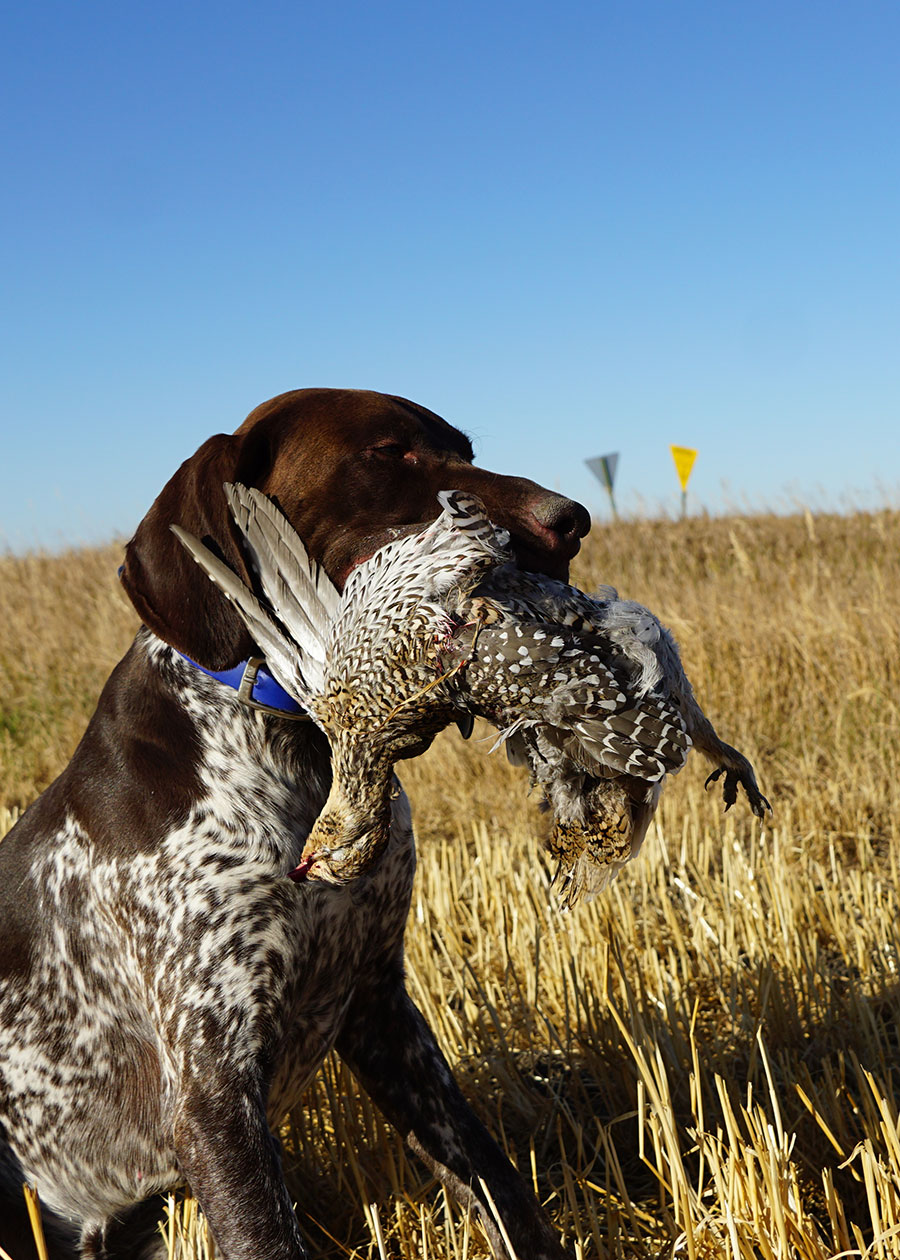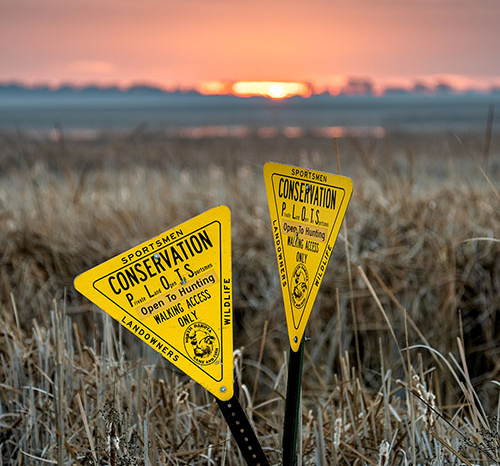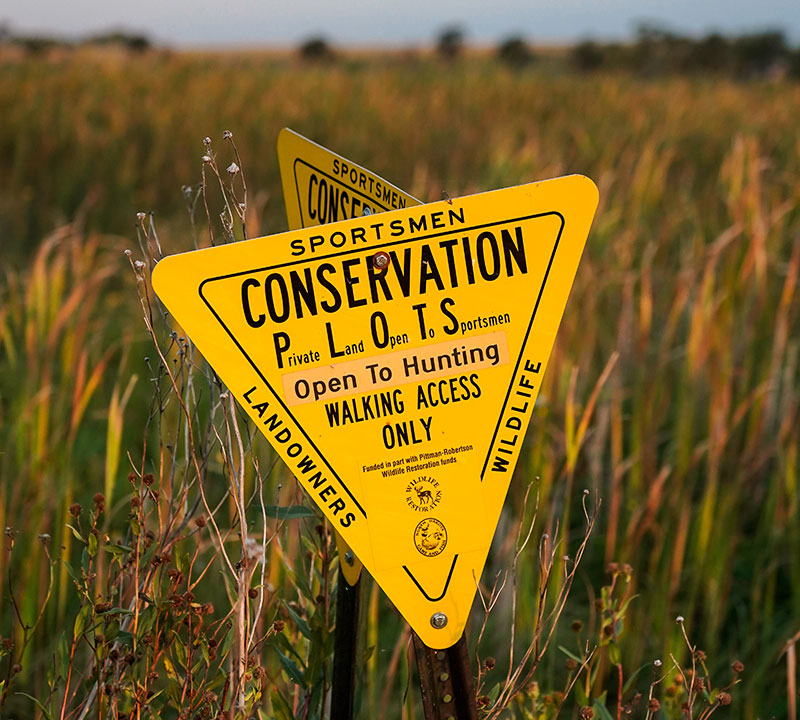North Dakota Landscape Staple
Editor

North Dakota Game and Fish Department Private Land Open To Sportsmen signs were first added to the landscape in the late 1990s in six counties – Adams, Dickey, Divide, Grant, Hettinger and Morton – primarily because of their importance to pheasant hunting. Today, these familiar yellow signs are found statewide.
Kevin Kading, Department private land section leader, addresses the status of the walk-in access program that is easily recognizable and popular with more than a generation of hunters.
NDO: The 2022 PLOTS Guide was made available to the public in August. How many PLOTS acres are featured in the guide this year?
Kading: Overall, the PLOTS Program is sitting about the same as 2021 at about 800,000 acres. If we split the program into two regions, the western region of the state did see a little bit of a decrease in acres, while the eastern region saw a little bit of an increase in acres.
NDO: PLOTS acres expire throughout the year. Explain that?
Kading: That’s part of the nature of private land programs. These are private lands enrolled in an agreement with the Game and Fish, so some agreements with landowners are as short as two years and some of them are longer than that, maybe up to 20 years. And every year we’re always chasing those agreements that are expiring and working with landowners to give them an option to renew. Some do, most do, but some don’t. And then we also have new acres coming into the program. In a way, that’s kind of a nice thing to kind of move things around a little bit. Hunters get new options and new opportunities to hunt different areas that they haven’t hunted. But you also have some that have been on the landscape or in the program for a long time and hunters like to go back to some of those areas, too.
NDO: A year ago North Dakota was in the middle of a drought. How are things looking this year?
Kading: It’s just been unbelievable, with the rebound and the recovery of the grasslands across the state. From a wildlife standpoint, it’s going to help a lot. And from hunting cover, habitat wise, the PLOTS tracts are looking a lot better this year. Just in general, everywhere across the state looks a lot better. Certainly, hunters will find some better cover this year on PLOTS tracts.

NDO: Let’s talk about haying on PLOTS acres. Last year a lot of PLOTS acres were hayed in response to the dry conditions and the dire need for feed for cattle. Does that happen every year?
Kading: There a lot of different things going on with PLOTS agreements. Some of the agreements are tied in with the USDA program, for example, like CRP. And so, they must follow provisions of their CRP contract. We do restrict some haying so there’s habitat left out there at the end of the year, we don’t want to see it all hayed, but we also understand it’s an opportunity for producers to get some forage off those acres. We get some management out there that you might not otherwise get, and those grasses need something. Nearly all PLOTS agreements have some ability for haying or grazing. We typically wait until after Aug. 2 for haying to take place. That just helps birds get off the nests, get the broods out moving around so they can escape the sickle mower and the hay binder.
NDO: Let’s say a hunter pulls up to a PLOTS tract and they find some nice habitat, but the rest of the field is crop. Why is that?
Kading: Not every PLOTS agreement is the same and not every PLOTS acre is the same. Some of our PLOTS agreements you might see some more cropland. Some might have more pastureland, and some might have some hay land. The bottom line is that Game and Fish biologists wouldn’t sign those acres up if there wasn’t some hunting value out there somewhere. And that could be, for example, waterfowl hunting access in a stubble field. It could be a wetland on the back corner. It could be that there’s management being performed out there. So, maybe the year that you show up out there, it might be a stubble field, but if you come back in two years it might be a newly planted grassland that’s being developed for wildlife habitat.
NDO: Let’s talk about the PLOTS Guide. Obviously, hunters can get their hands on a physical PLOTS Guide, but they can access the guide electronically as well.
Kading: Like everything else in today’s world, a lot of stuff is going electronic, and PLOTS is no different. The PLOTS Guide is still produced and published in the printed form, but every year that seems to go down a little bit or is in less demand. More hunters are using smartphones and different apps on their phones or accessing it on our website. Either way, people that still want to get a printed guide can still get their hands on that as well.
NDO: Address some of the rules and regulations and hunting ethics on PLOTS acres.
Kading: First and foremost, the PLOTS tracts are for walk-in hunting access. Anything other than walk-in access for hunting requires landowner permission. One of those things that require landowner permission is if you wanted to go out there and do some shed hunting. Other things to be aware of when you’re out on a PLOTS tract hunting, we don’t necessarily have designated parking areas because they’re private land. There’s usually a field approach or a place that you can get off the road, so hunters need to make sure you do that to avoid accidents, stay out of the way of equipment, farm machinery, that type of thing. But also, don’t block a gate, try to move off to the side if you can. And when it comes to gates, make sure they’re left the way you found them. Sometimes they’re open for a reason, maybe the landowner is hauling grain or hauling hay in and out of there. But if they’re open, leave them. If they’re closed, close them. Most of the time, you don’t need to be driving in on those areas anyway. A lot of times you shouldn’t be. For the most part, we just want hunters to remember these are private lands and treat them with respect, treat them like it was your land. Typically, most hunters are doing the right thing. We don’t have a lot of problems, but we’ve had landowners not renew their PLOTS agreements just because of poor hunter behavior. Keep that in mind and know that your actions make a difference out here. If hunters want more PLOTS acres and they want to continue to enjoy PLOTS acres, we all need to treat them with respect.
NDO: Hunters should pick up their spent shells, litter and whatever they introduce to the landscape.
Kading: We just want people to just do the right thing out there. If you see someone else’s garbage, pick it up if you can. Remember the little things like shells. In a field-hunting situation for waterfowl, hunters can get into situations where they are shooting a lot and a lot of shells end up in the field, and it really doesn’t take a whole lot to pick those up. But I’ve heard producers over the years say they don’t like coming across that, they’re going out there farming and they see a pile of empty shell casings.
NDO: How about trapping, cable devices? You said PLOTS are just for hunting, but how about trapping?
Kading: Trapping in North Dakota does require written landowner permission. So, whether you’re on a PLOTS tract or just on private land, you need written permission. If you’re out there with a hunting dog, be aware there could be traps or snares. And if you’re a trapper or a snarer, make sure you’re aware of that too, and that might not be the best place for setting up snares if you have people and hunting dogs out there. PLOTS tracts are typically hunted for upland game and waterfowl, so there’s usually dogs involved and it’s just not a good combination if you can help it. But after the bird season, after upland game bird seasons, that’s when a lot of people start doing their snaring anyway.
NDO: We already mentioned a little bit about habitat, but let’s talk about habitat on PLOTS land.
Kading: We do have a lot of good habitat on PLOTS and we’re always working to manage more habitat. In the last 10 years it’s become more difficult to maintain habitat on PLOTS and to enroll good lands that have a lot of habitat. The reason for that is pretty simple when you look across the state at our shrinking habitat base. We talk a lot about CRP, and that’s one thing that’s very noticeable. We had 3.5 million acres of CRP, now we’re down to a little over 1.1 million acres. And not all of those acres are not in grass anymore. Some of those are still in grass. Maybe they’re still being hayed or grazed or something. But a lot of those have gone to ag production. We’re not putting blame on the producer for doing that. A lot of times they even tried to get it back into CRP, but they weren’t accepted, or it didn’t meet the criteria. And so, the habitat base in North Dakota has shrunk quite a bit in the last 10 years, and that happens on PLOTS as well. Where before it was easy for us to enroll good quality lands because the habitat base was there, the Department is having to spend more time on developing habitat as well, which costs more money, takes more time. A lot more goes into planting a field with grass and developing that habitat than it did before. It’s just a little bit more of a challenge than it was just five, 10 years ago.
Plots Online

The North Dakota Game and Fish Department’s Private Land Open To Sportsmen Guide for 2022 is available online on the Department’s website, gf.nd.gov. In addition, the free printed PLOTS guides are available at most license vendors and other locations throughout the state.
The guide features about 800,000 PLOTS acres. Because the guide is printed in mid-August, some PLOTS tracts may have been removed from the program since the time of printing. There will also be some PLOTS tracts where the habitat and condition of the tract will have changed significantly. Conversely, Game and Fish may have added new tracts to the program after the guide went to press.
To minimize possible confusion, Game and Fish will update PLOTS map sheets weekly on its website.
The PLOTS Guide features maps highlighting these walk-in areas, identified in the field by inverted triangular yellow signs, as well as other public lands.
The guides are not available to mail, so hunters will have to pick one up at a local vendor or Game and Fish offices or print individual maps from the website.
